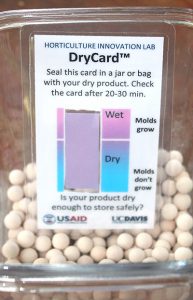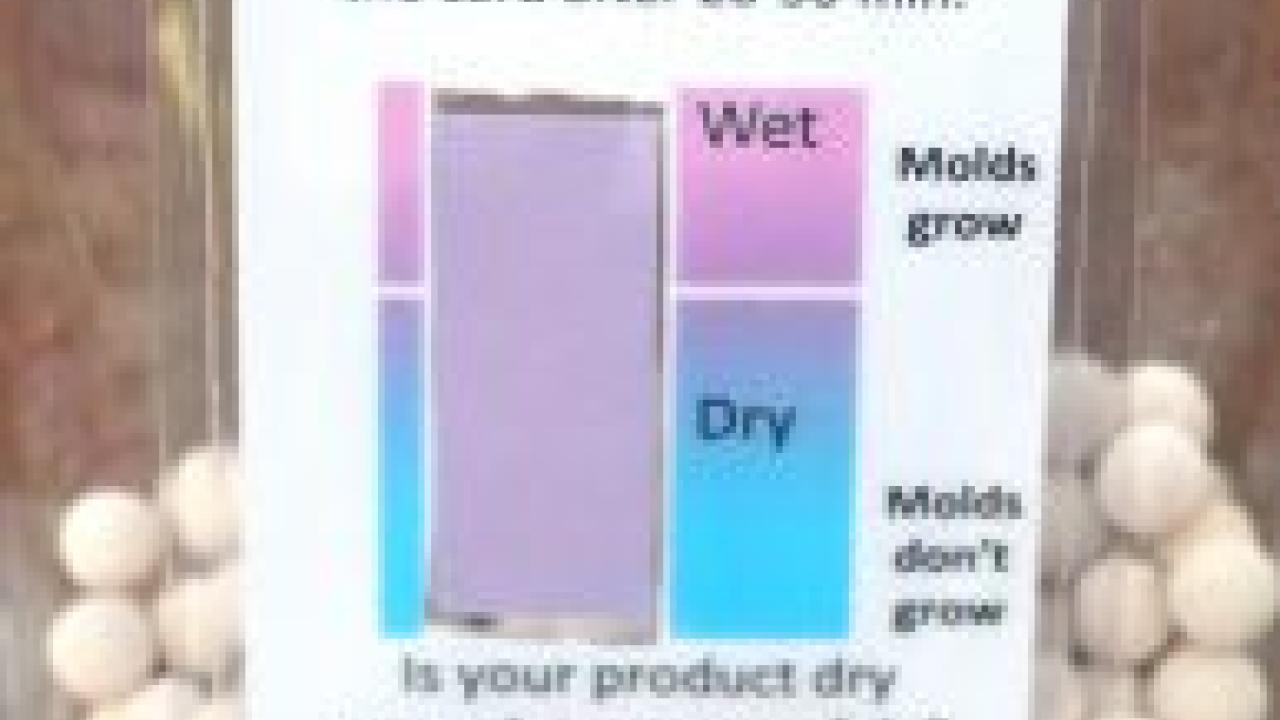
Inventing a Low-Cost Solution to Reduce Moldy Foods: 'DryCard' Takes the Guesswork Out of Drying
How do you see dryness? Solar drying is a simple way for smallholder farmers to preserve their harvest, but knowing when food is dry enough to store is complex. UC Davis researchers invented a low-cost, easy-to-use tool that farmers can use to measure food dryness, called the DryCardTM.
In developing countries, mold growth on dried foods is a pervasive problem, which can mean postharvest losses for farmers and unsafe foods for consumers. When mold grows it reduces the market value of dried foods, meaning less income for farmers. But moldy foods can also contain toxins that suppress the immune system, increase disease rates, and cause lifelong stunting in children.
Trip to market inspires a solution
Improving the postharvest drying process for smallholder farmers is something UC Davis scientists Michael Reid and James Thompson think about often. As UC Cooperative Extension specialists, Reid and Thompson have a history of working together in California and around the world on postharvest technologies, including adesign fora more efficient solar dryer.
Last summer Reid led a Horticulture Innovation Lab workshop in Tanzania to provide training in postharvest handling of fruit and vegetable crops. The class visited the local market and tested the moisture content of some of the dried foods for sale. They found huge variation between the moisture contents of dried foods -- over half were insufficiently dried and susceptible to mold.
It was then Reid realized the magnitude of the issue.
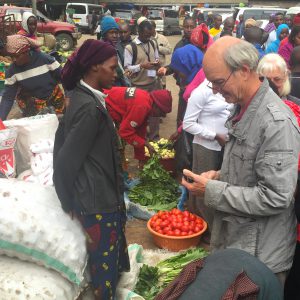
Michael Reid (right) takes a photo on the market visit in Tanzania with participants in a postharvest training course, which motivated the eventual design of the DryCard. (photo: Angelos Deltsidis/UC Davis)
"The effects of mold are so pervasive they aren't even really quantifiable," Reid said. "Only a small percentage of farmers lose their entire harvest to mold. Usually they end up selling moldy foods at a lower price."
The moldy foods make their way to consumers' plates where they continue to have harmful effects. "There is a tremendous problem with stunting in developing countries. People commonly think of this problem as only a nutrition problem [related to insufficient diet], but moldy foods play a significant role," he said.
Developing a tool that costs pennies to make
Galvanized by his experience at the market in Tanzania, Reid teamed up with Thompson once again, this time to develop a simple and inexpensive product to measure food dryness.
They considered electronic moisture meters, but with prices ranging from $300-$1,000, plus the requisite electricity and expertise, meters seemed unsuitable for many smallholder farmers.
The two then considered cobalt chloride paper, used by the class in Tanzania. Cobalt chloride indicates dryness by changing color, but the lightweight papers got lost in the test jars, and when they were visible, they were difficult to compare to a separate color guide. To address this issue, Reid and Thompson paired a strip of cobalt chloride paper with a color guide on a laminated piece of paper the size of a business card. Repackaging the cobalt chloride paper with the color guide increases the usability of the strips and further lowers the cost to just pennies per card for farmers to use.
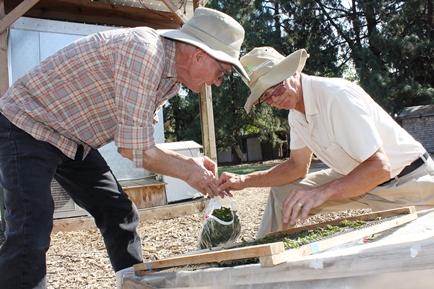
Jim Thompson and Michael Reid, UC Cooperative Extension specialists and co-inventors, work on a drying experiment with kale at the Horticulture Innovation Lab's Demonstration Center at UC Davis. The two designed the DryCard and the chimney solar dryer. (photo: Brenda Dawson/UC Davis)
How to check dryness with the DryCard
To check that food is dry enough for safe storage, farmers can seal a DryCard and a sample of dried product in an airtight container. After 20-30 minutes, the card indicator changes color based on the relative humidity within the container and thus the product. The DryCard is based on the concept that relative humidity of air around a product reflects the moisture content of the product ("equilibrium relative humidity"). Matching the color of the indicator strip with the scale on the card tells a user whether the food is currently dry enough to prevent mold growth.
The DryCard is reusable as long as it is stored safely away from water.
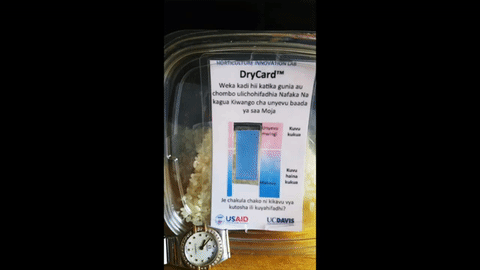
This 8-second gif shows a timelapse of a DryCard changing color with insufficiently dry rice. This clip is taken from a 5-minute video made by Michael Reid. View the video here https://www.youtube.com/watch?v=wDujgVXaAYQ&feature=youtu.be
Thompson pointed out that anyone can use the DryCard to assess the moisture content of a variety of foods.
"The DryCard requires zero calibration and can be reused many times for any kind of food you want to keep free of mold," Thompson said. "Everything is on the card. The cobalt chloride strip is attached so it's easy to keep track of, and the color guide is right there."
DryCard as part of the dry chain for food safety
Drying foods for storage is important for farmers because it provides them with additional income and food security beyond the harvest season. The Horticulture Innovation Lab works with several innovations along the "dry chain" (similar to the cold chain) including the UC Davis chimney solar dryer and drying beads. The DryCard is a valuable addition to the dry chain, providing a way for farmers and others to easily measure food dryness.
Getting DryCards into farmers' hands
The Horticulture Innovation Lab team is currently working with organizations in Tanzania, Kenya, Zambia, Bangladesh, and Guinea to test the DryCard with farmers and others who handle dried foods along the supply chain. Reid and Thompson envision local opportunities for entrepreneurs in developing countries to manufacture and market DryCards, to help make this tool more widely available for farmers to use.
DryCards are currently available as samples in English, Swahili, Bangla, Urdu, Spanish, and French. See http://drycard.ucdavis.edu for additional details.
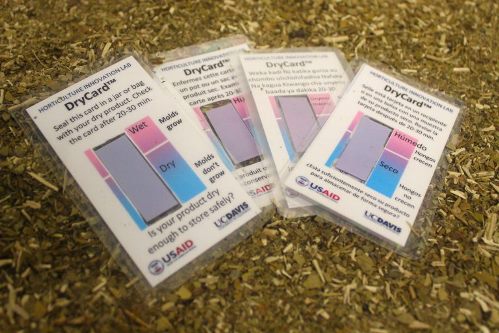
DryCards are available in English, Swahili, Spanish and French (also in Bangla and Urdu, not shown) as samples from the Horticulture Innovation Lab.
The Horticulture Innovation Lab is funded by the U.S. Agency for International Development as part of the U.S. government's global hunger and food security initiative, Feed the Future.
Photo at top: Tomatoes dried in the chimney solar dryer, during an experiment led by Reid and Thompson at the Horticulture Innovation Lab Demonstration Center at UC Davis.
More information:
(Original article by Katie von der Lieth, Horticulture Innovation Lab, UC Davis)
- - - - - - - - - -
[For past Plant Sciences news, go to https://news.plantsciences.ucdavis.edu/]

